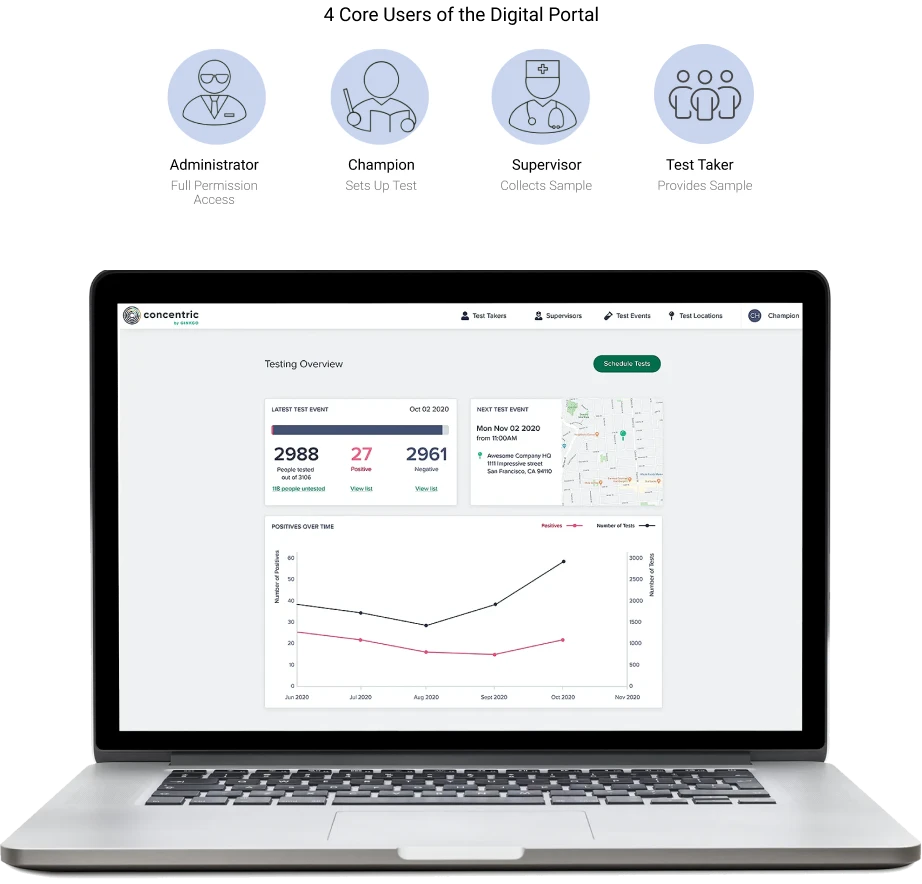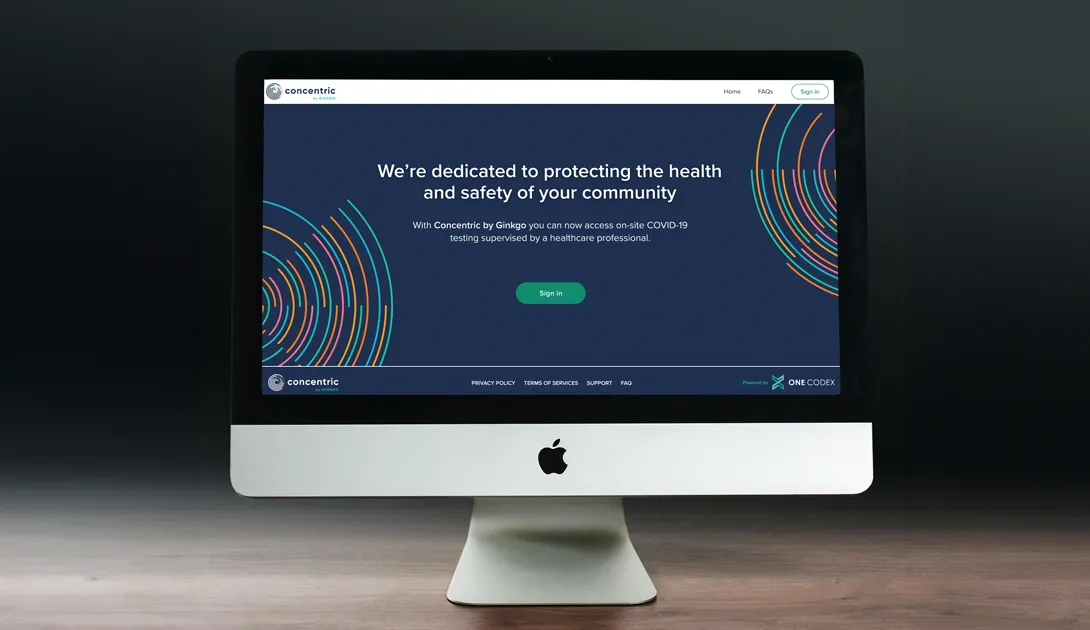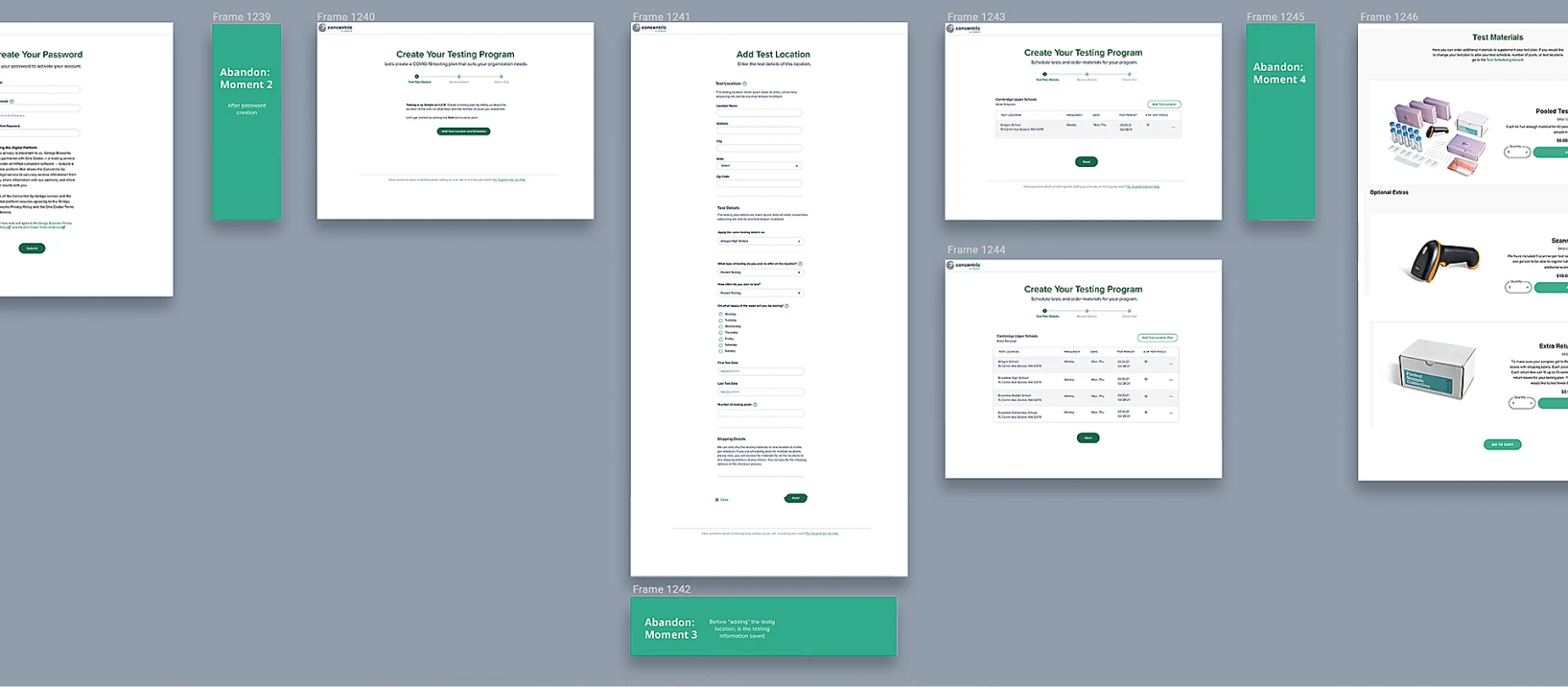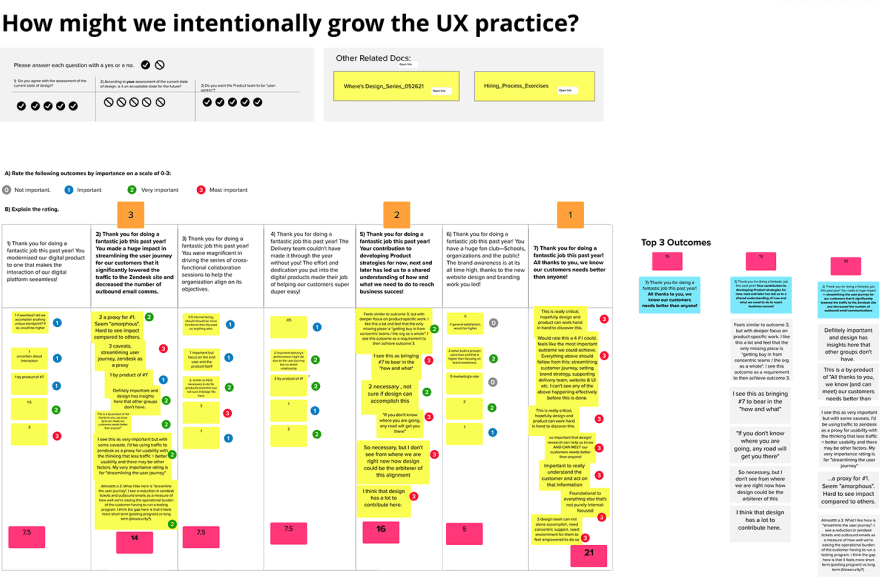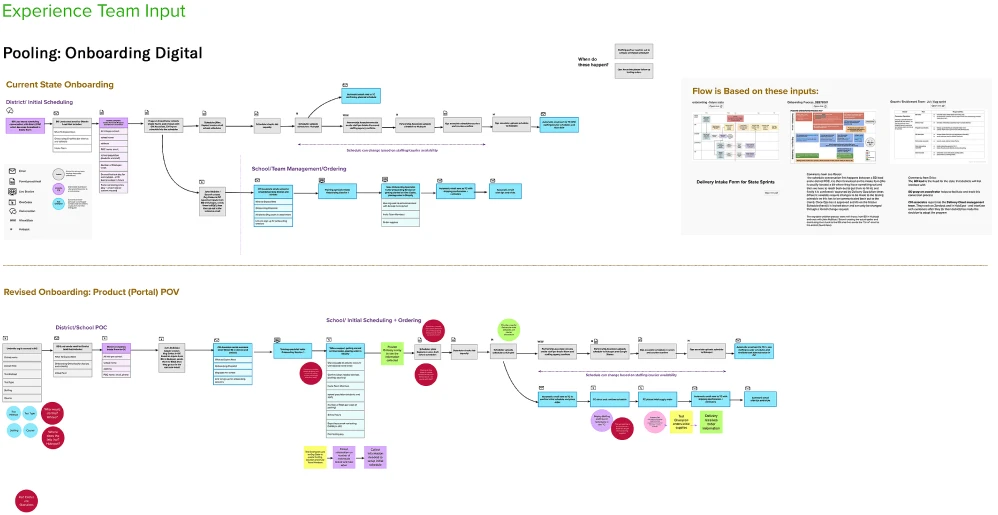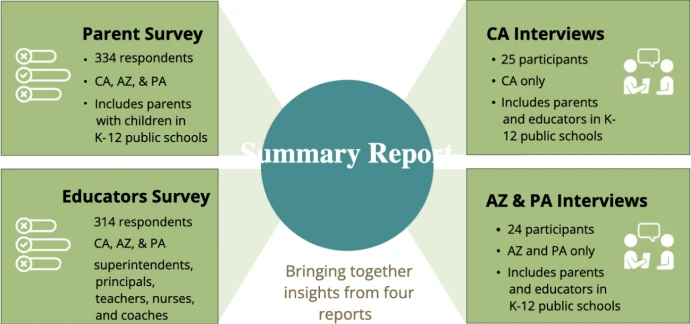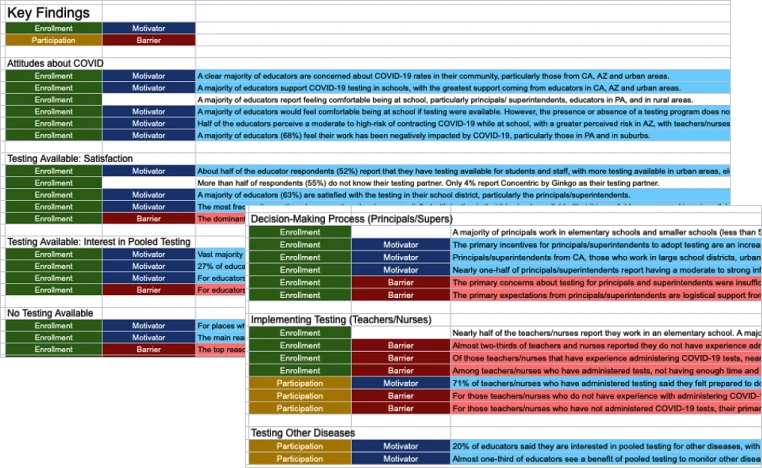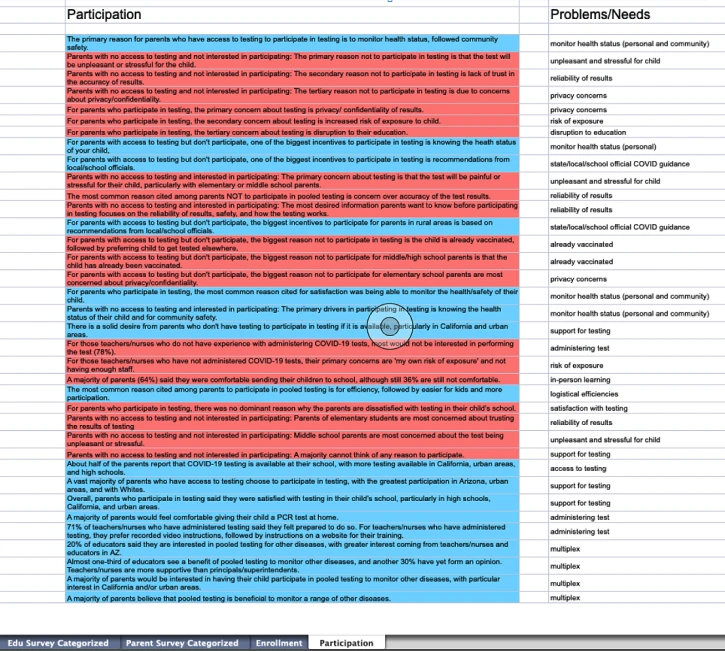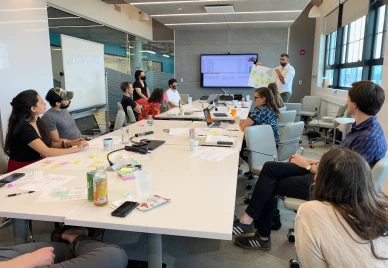Director, Experience Strategy & Research, 2022
Navigating through the unknown
Leveraging Human-Centered Design to thrive amid ambiguity and prepare for the unexpected
In 2020, Ginkgo Bioworks capitalized on its existing biotechnology platforms by actively supporting COVID-19 response efforts amid the pandemic, thereby establishing a new business unit called Concentric.
Amidst the rapidly evolving global dynamics of this uncertain time, where a swift response was evidently crucial, the need for business agility within became apparent. Operations scaled up exponentially, fueling the accelerated expansion and culminating in its successful IPO in 2021.
Assumption
Abundant data on startup growth patterns indicates businesses experience rapid growth within a condensed timeline. Leveraging these insights,
I assumed that Concentric would experience significant expansion and transformation, surpassing its current capacity while testing business viability.
This assumption guided the foundation of the strategies I devised for this engagement.
Stage of Startup Growth
Slingshot.io
Opportunity
In anticipation of the ‘Test’ and ‘Growth’ stages Concentric may experience, my recommendation focused on formulating strategies to prepare for and mitigate potential operational disruptions amid rapid changes in turbulent times.
Strategies for implementing human-centered design methodology to transform the business that can:
• Craft short-term results that compound into long-term gains
• Foster resilient mindset & skillset that embrace uncertainties
Problem Statement
How might we leverage Human-Centered Design methodology to scale the business sustainably in the face of uncertainties?
Role & Responsibility
Role
• Human-Centered Design Leader
• Growth Driver
• Experience Strategist
• Hands-on Product Designer
• User Researcher
• Supporting Product Manager
• Customer & User Advocate
• Brand Evangelist
• Change Agent
Responsibility
• Defined & Built MVP
• Led Design Thinking
• Built Design & Research Practice
• Instituted Customer-Centricity
• Implemented Continuous Learning
• Explored the Unknown
• Tested & Iterated
• Embraced Challenges
• Increased Design Maturity
My Strategy
Dual-Track Innovation
TRACK 1
Today: Strengthen the Business
Stage 1: Demonstrate Design Value
Stage 2: Build, Test, Learn
TRACK 2
Tomorrow: Prepare for the Unknown
Stage 3: Align Product Organization
Stage 4: Shift Org Mindset + Skillset
Outcomes
Drove Evolution of Design Maturity
flag
STAGE 1
Demonstrated Design Value
flag
STAGE 2
Built, Tested, learned from MVP
flag
STAGE 3
Aligned Product Organization
flag
STAGE 4
Shifted Organizational Mindset + Built Skillset
Output
Key:
arrow-progress
Process:
laptop
Product
people-group
Management
BUSINESS
Week 1:
Asked the Senior Leadership 5 questions.

PRODUCT
Week 1:
Assessed product experience and heuristics


BUSINESS
Baseline Assessment:
Low UX Maturity

PRODUCT
Baseline Assessment:
Low UX Maturity


people-group
Stage 1 — Baseline: Established the current state of skills, knowledge and mindset; Identified business goals and priorities and assessed the product experience



laptop
Stage 1 — Foundation: Implemented team workflow aimed at maximizing the capability of the Product Team; Designed foundational elements and standards: Design System, Pattern Library, Usability best practices, UX Writing

laptop
Stage 1—MVP: Designed essential functionality for the MVP launch to address core users' basic needs; Measured results, gathered insights, and incorporated them into the product backlog

laptop
Stage 2 — Digital Product Expansion: Revamped the site architecture to facilitate transition to a self-service model; Significant upgrades for new partnerships w/ Correctional Systems & Airlines; Net new offering of Tableau dashboard


arrow-progress
Stage 3 — Team Efficiency: Devised workflows to optimize the Product team’s capability from conception to execution; Coached the young Product team on best practices of Agile and UX to deliver repeatable & measurable outcomes

people-group
Stage 3 —Intentional Growth of Product Team: Practiced Design Thinking to improve Product org’s efficiency; Led workshops to define skills gap so that we could grow the UX practice with intention that aligns with business goals

arrow-progress
Stage 4—Mindset Shift: Drove cross-functional activities to develop solutions around journeys (customer & employee) and holistic experience versus in isolated silos such as by features and user stories.

Today: Concentric provides public safety monitoring services through “Intercepting”, utilizing PCR and Pooled testing.
Tomorrow: Beyond the pandemic, the business seeks to transition into an ongoing surveillance model to prevent future threats to public health.
How might Concentric adapt and evolve the business post-pandemic?
Launched LX Initiative
Lean Experience
circle-1
Right Problem
for the user
circle-2
Right Solution
for the user
circle-3
Build it Right
for the user
circle-1
Right Problem
user-group
Led 2 teams of 15+ User Researchers; Daily dissemination of up-to-date significant data
angle-90
Solution Space Research
To equip the business with the insight needed to improve and evolve the current end-to-end experience offerings
frame
Problem-Space Research
To equip the business with the insights necessary to shape various strategies for future business opportunities
circle-2
Right Solution
user-group
Led the efforts across multiple workstreams to analyze and interpret data effectively; Identified leading indicators for disruption and proactively addressing feature inflation.
circle-3
Build it Right
user-group
Led a multi-disciplinary team in planning and prioritizing activities to implement insights derived from research, using a user-centric framework to inform the product roadmap.
comment-lines
Response to the LX Initiative at the Product Offsite
… gives me a level of security knowing that we are planning ahead.
“…everyone is anxious for this, but until we create SPACE from reactive work, I’m not optimistic we’ll make progress…it feels like we’d talk about it, but then go back to reactive work after onsite.”
“…I think it is critical that Ginkgo finds a way to get ahead of the feature inflation.”
“…we have to be a fast strike force for deploying relevant critical changes fast in order to scale, reduce manual work on delivery and not hinder adoption.”
“…seems like it has the potential for the biggest impact for the organization (and I think is largely desirable)”
“…is hugely valuable and an important skill for us to have in our toolbox
“…we have a unique opportunity to align on a deeper level than we normally have while working remotely. I’d also hope that if we aim to align we will naturally do some learning and gain some relief along the way. Align!”
“…it would expose engineers to the earlier part of the process.”
“…reactive work is really hurting us at the moment”
“…we are wasting a lot of cycles releasing or partially implementing the “wrong” thing far too often. “
“…builds credibility and creates common ground for design and product to constructively work together… tangibly show how we can create value for the team”
“…bc tbh I feel like I don’t know what we’re going to be doing this coming summer given that pooled testing likely goes away.”
“…a good exercise to get the team to rally around the learnings we have.“
Democratized information + Built trust + Achieved alignment
people-group
Stage 4—The Future: Practiced Human-Centered Design as a conduit to innovation & growth to deliver the highest possible value to the customers and protect public health safety from future outbreaks.
Success Metrics
Key:
arrow-progress
Process:
laptop
Product
people-group
Management
Increased Usability Heuristics rating of the digital products from 2 to 8 /10
laptop
Strengthened partnerships between PM/UX/Dev by fostering early and frequent collaboration
arrow-progress
Increase Product competency in UX and Agile leading to reduced lead time to feature releases and higher throughputs of testing
arrow-progress
Elevated UX maturity across disciplines by operationalizing design and research processes and championing UX best practices
arrow-progress
Scaled up UX & Research practice and team of 1 to 20+ member
people-group
Enhanced Product visibility within the org by actively shaping positive business outcomes through innovative solutions tailored to customer needs
people-group
Reduced feature bloat by instituting a practice of formulating hypotheses, conducting tests, and measuring results
laptop
Shifted mindset within leadership to practice Design Thinking to explore new business opportunities
people-group
Delivered diverse digital offerings to cater to the rapidly growing demand across various verticals and for self-service solutions
laptop
Enhanced employee experience and satisfaction through organization-wide design thinking workshops & activities
arrow-progress
Bolstered the success of the self-service model with improved omnichannel experience
laptop
Increased dedicated time for UX & Research within the Agile product development lifecycles
arrow-progress
Barriers
Limited data on the public’s attitudes and behaviors toward the pandemic hindered quick adaptation
Unprecedented nature of the pandemic led to a persistent reactive workflow
Unclear signals of the pandemic caused constant shifts in business priorities
High-velocity environment precipitated a multitude of redundancies across teams and workstreams
Organization’s superior scientific knowledge fostered a misplaced confidence in product development
Key Takeaways
"Who moved my cheese?"
As the Director of Experience Strategy and Design, I championed and operationalized human-centered design, providing structured frameworks to managing uncertainties with purpose and intention. I formulated strategies, planned activities, and effectively executed solutions tailored to the customer’s and employees’ needs.
During this process, I made two revealing and salient observations:
- Individuals exhibit varying tolerance to change, from enthusiastic acceptance to resistance
- There is a direct correlation between these tolerance levels and the success of adoption
In Dr. Spencer Johnson’s book “Who Moved My Cheese?”, the cheese served as a metaphor for life’s challenges and uncertainties. The story follows 4 main characters (mice), each representing different responses to change, ranging from quick acceptance to resistance.
Similarly, when Concentric embarked on testing a new business model amidst a global health crisis, individuals at all levels of the organization responded differently to the changes:
Some experienced fatigue from the high levels of change saturation
While others embraced the process, driven by the prospects of a brighter future.

As design leaders, we often function as change agents, proposing necessary changes based on evidence and research findings. However, it’s less common to propose how the change should be managed within the organization to ensure universal adoption.
Upon reflection, I realize that implementing strategies to manage change could have significantly improved the outcome of this engagement. Research from PROSCI, a global leader in change management solutions, indicates that effective change management increases the likelihood of meeting objectives by 7X.
Based on this experience, I hypothesize that an organization’s adaptability to change might be a leading indicator of business success. After all, organizational outcomes are the collective result of individual changes. To improve adoption and success rates for future change proposals, I earned a PROSCI certification.

